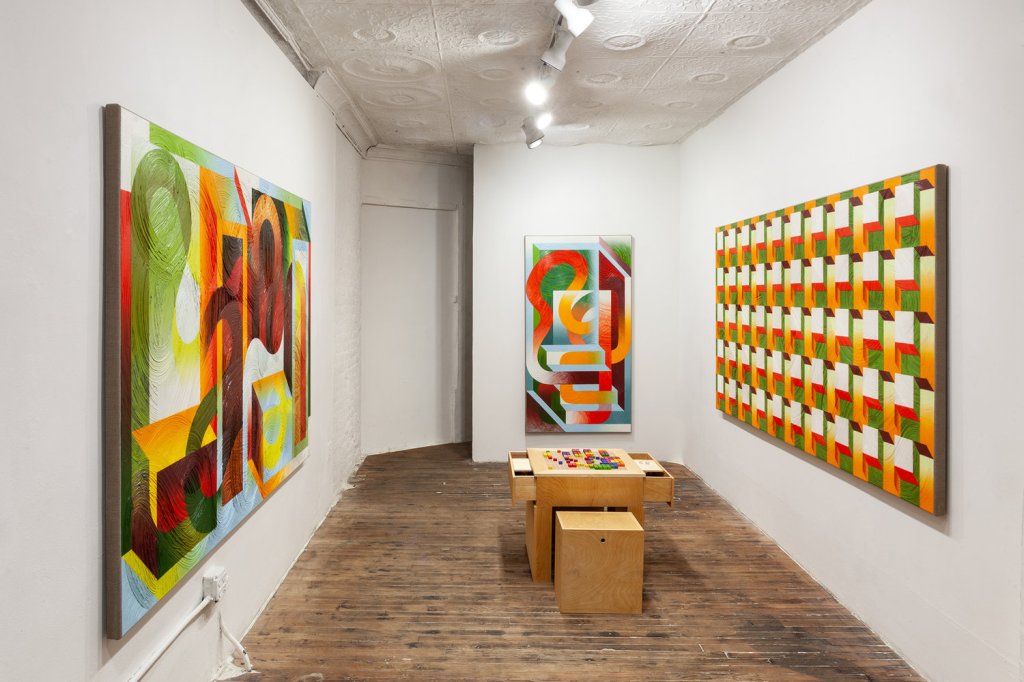[ad_1]
In order to visit Mariah Dekkenga’s current show, “Non-Zero Sum,” at Situations on the Lower East Side of Manhattan, one has to make a series of choices. What time to leave to make it there? At the subway station, run to make the train? Wait for the walk sign at the crosswalk or jaywalk? Say hello to old friends on the sidewalk?
Inside the compact gallery are three large, bright abstract paintings and, on a wooden table, a pair of dice and multicolored blocks. Two people are sitting on compact stools, casually playing some kind of game. Printed directions provide only the most minimal rules, but you can pick it up by watching. The players take turns rolling the two dice and placing small, brightly colored cubes into a gridded game board. The numbers they roll correspond to the total cubes they can place down during their turn. And they keep going until the board is full.
It is what is known in game theory as a non-zero-sum game—where one player’s decision does not necessarily result in the other player’s loss or gain. The winnings and losings of all the players do not add up to zero. Everyone can gain, in other words: a win-win game. This philosophy feels out of step with our current culture. Why play a game just for the sake of playing?
This isn’t the first time that Dekkenga has experimented with games that have no defined winners. Previously, she created a deck of painted cards—an object multiple—with tonalities broken into complementary colors: red/green, orange/blue, and yellow/purple. This simple deck has no set rules of play—only suggestions, printed on cards, are included. One might see it as a tarot deck for color theory, a playful step beyond Josef Albers and Johannes Itten.
Dekkenga, who is based in Randolph, Vermont, and Doha, Qatar, is adept at using programs like Photoshop and Illustrator to generate painting compositions and color schemes, and while her paintings utilize her own rules and strategies, there is no winning the arbitrary logic of abstraction.
Her game could be understood as a manual for interpreting these intricate paintings—graphic tableaux of hard edges and curves in soft focus—of making sense of these open-ended performances of forms and information. Of the three paintings on view, the largest seems to have the strictest rules: cubes push and pull from an impasto background. The other two paintings have a more informal internal order, with stairs and blocks fading into sharply curved forms, moving away from pure geometric abstraction.
Dekkenga once said that, for her, an optimal space to view her work is a place of contemplation, like a library or museum, where one can spend time mulling philosophical thought or theory. She achieves this in her exhibition through her game—“A Two Player Game Without Opponents,” she’s titled it—where playing the back-and-forth action slows down the read of the show. Without mediation through a digital device (this game could easily have been an app), it forces the viewer to interact leisurely with physical objects (game pieces and paintings) in order to experience the exhibition fully.
One leaves the show thinking about other choices: how we move through the ever-changing world we live in, and how that impacts our communities. One could intentionally buy local instead of from a big corporation, intentionally walk or take public transport instead of driving a car, intentionally seek out human interaction instead of using the self checkout or ATM.
One could intentionally seek out an exhibition by an emerging artist in a compact gallery and spend an afternoon playing a game that doesn’t necessarily have a winner in order to look at and contemplate abstract paintings that don’t necessarily reveal their answers readily. Those intentional choices might lead us somewhere or nowhere.
“Mariah Dekkenga: Non-Zero Sum” runs at Situations in New York through December 1.
[ad_2]
Source link


